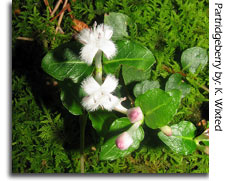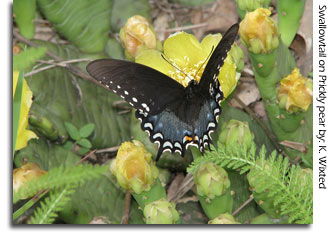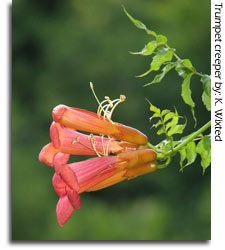Sprawling across the ground and spreading patches of green or gold is a job reserved not only for grasses. Ground covers are exactly what their name implies - plants that spread to form a carpet over the ground. Ground covers are gaining in popularity as an alternative over traditional lawn grasses and for good reason. Why? Well, traditional lawn grasses need lots of mowing, watering, fertilizing and weeding to be kept healthy and attractive. Most ground covering plants, on the other hand, need almost no maintenance once they have taken hold in your yard.
The Disadvantages of a Grassy Lawn
If you had a choice, then would you spend your weekends mowing? Probably not! The time spent mowing is often only a small part of the investment you have to put into an attractive lawn. Water, fertilizer, herbicides, cutting and edging can take a significant toll on our time and your wallet. The environment also suffers from our grassy lawns. All the excess chemicals used on lawns (and there is excess!) washes off after every rain, into streams and storm drains which eventually wash into the Chesapeake Bay. Herbicides kill stream vegetation needed by fish and other aquatic life. Fertilizers encourage algae to grow, causing eventual oxygen depletion in the water when the algae begin to die. Without oxygen in the water, few living organisms in the streams, rivers and the Chesapeake Bay can survive.
Lawns are no picnic for wildlife, either. Wildlife which use lawns are limited to species such as European starlings, Brown-headed cowbirds, American robins, squirrels, moles and sometimes rabbits. These animals, however, are not dependent upon lawns, and the vast diversity of wildlife found in Maryland is totally excluded from lawn habitats because lawns don’t provide necessary food, shelter or water.
The Alternatives
While grassy lawns have multiple disadvantages, there are alternatives available. Multiple species of groundcovers can be just as attractive as a grassy lawn and can grow successfully in Maryland. Described below are perennials available at most plant nurseries. They can be used in various parts of your yard, depending on soil and light conditions. Eventually, you may even want groundcovers as a replacement for a grass lawn.
Creeping phlox (Phlox stolonifera)
These creeping perennial species show off colorful flowers in tinges of blue, pink or lavender in early Spring. Creeping phloxes generally grow six to eight inches high and can take partial shade to full sun. Creeping phlox is great for areas that tend to erode easily and are considered to be deer resistant plants.
Juniper (Juniperus horizontalis)
Also known as "Carpet juniper", this evergreen plant provides a thick groundcover all year long. This juniper is usually blue in the summer, but may turn blue green in the spring and almost purple in the winter. However, there are many varieties of carpet junipers to choose from. Junipers are most useful in full sun, especially where dryness is a problem. Small cuttings require spacing of about one foot; larger mature plants require spacing of about two or four feet. Total coverage for small cuttings is about two to three years. While this species is not native to Maryland, it is not invasive.
Moss phlox (Phlox subulata)
Similar to the Creeping phlox, Moss phlox is a creeping perennial plant that enjoys sunny conditions. This species only gets about six inches in height and produces flowers in hues of pink and white. Both species of phlox are beneficial for butterflies.
 Partridgeberry (Mitchella repens)
Partridgeberry (Mitchella repens)
Partridgeberry is a small, perennial groundcover which reaches a maximum height of one to two inches. Despite its diminutive size, this plant provides dark green leaves throughout the year along with splashes of red berries in the late summer and fall. The red berries are consumed by a variety of wildlife species, and in the spring, the white trumpeted flowers are visited by early pollinators.
Sedums (Sedum spp.)
Sedums come in many shapes and colors. These small succulents have fleshy leaves that help them survive in sunny areas. Also known as stonecrops, Sedums typically are low-growing annuals or perennials that form mats across the ground. Some Sedums are bluish-green while others can be a dark green color. Sedums are typically full sun species and generally require one to two feet of spacing in between plants. Sedums are great in rock gardens or along edges of walkways and gardens.
Other Ground Covers
There are many plants with spreading capabilities, which are not often thought of as ground covers. Many of these have direct benefit to wildlife. These plants include flowers, vines and shrubs. A list is provided below. To choose which plants will do best in your particular situation, you will need to consult with a local nursery and/or a few gardening books.
Shrubs
Bearberry (Arctostaphylos uva-ursi), native
Black Crowberry (Empetrum nigrum), non-native
Blue-ridge blueberry (Vaccinium pallidum), native
Bunchberry (Cornus canadensis), native
Lowbush blueberry (Vaccinium angustifolium), native
Trailing arbutus (Epigaea repens), native
Wintergreen (Gaultheria procumbens), native

Perennials
Christmas fern (Polystichum acrostichoides), native
Foam flower (Tiarella cordifolia)
Golden Ragwort (Packera aurea)
Mayapple (Podophyllum peltatum), native
New York fern (Thelypteris noveboracensis), native
Plantain lily (Hosta spp.), non-native
Prickly pear cactus (Opuntia humifusa), native
Pussytoes (Antennaria spp.)
Showy evening primrose (Oenothera speciosa), non-native
Strawberries (Fragaria spp.)
Violets (Viola spp.), native
Virginia bluebells (Mertensia virginica), native
Wild Blue Violet (Viola sororia)
Wild geranium (Geranium maculatum)
Wild ginger (Asarum canadense), native
Yarrow (Achillea spp.)

Vines
American bittersweet (Celastrus scandens), native
Crossvine (Bignonia capreolata), native
Trumpet creeper (Campsis radicans), native
Virginia creeper (Parthenocissus quinquefolia), native
Ground Covers to Avoid
Not all ground covers are created equal, and it is important to be aware that some readily sold ground covers are invasive. Invasive species are non-native species that cause problems like crowding out native species and changing soil environments. The following list is comprised of plants sold that are known to be invasive in Maryland. If possible, then you should avoid planting these in your yard.
- Carpet bugleweed (Ajuga reptans)
- Creeping Jenny/Moneywort (Lysimachia nummularia)
- English ivy (Hedera helix)
- Japanese wisteria (Wisteria floribunda)
- Lantana (Lantana camara)
- Lily-of-the-valley (Convallaria majalis)
- Pachysandra (Pachysandra terminalis)
- Periwinkle (Vinca minor)
- Vinca vine (Vinca major)
- Yellow Archangel (Lamiastrum galeobdolon)
How to Plant Ground Covers
Before you begin, check with your nursery or garden center about the best type of ground cover for your needs and situation. Once you have selected plants, then Roto-till and work in topsoil to about six inches in depth.
Be sure to place ground covers at recommended intervals. (Note: Consult plant tags for spacing information or use garden books).
Once planted, apply mulch one to two inches deep around ground covers. Place plants closer together for quicker coverage of area. For larger areas where cost of plants can be a factor, spacing plants further apart will generate slower coverage but will be easier on your budget.
Invite Wildlife to Your Backyard!
For more information, please contact:
Maryland Department of Natural Resources
Wildlife and Heritage Service
Tawes State Office Building, E-1
Annapolis MD 21401
410-260-8540
Toll-free in Maryland: 1-877-620-8DNR
[email protected]